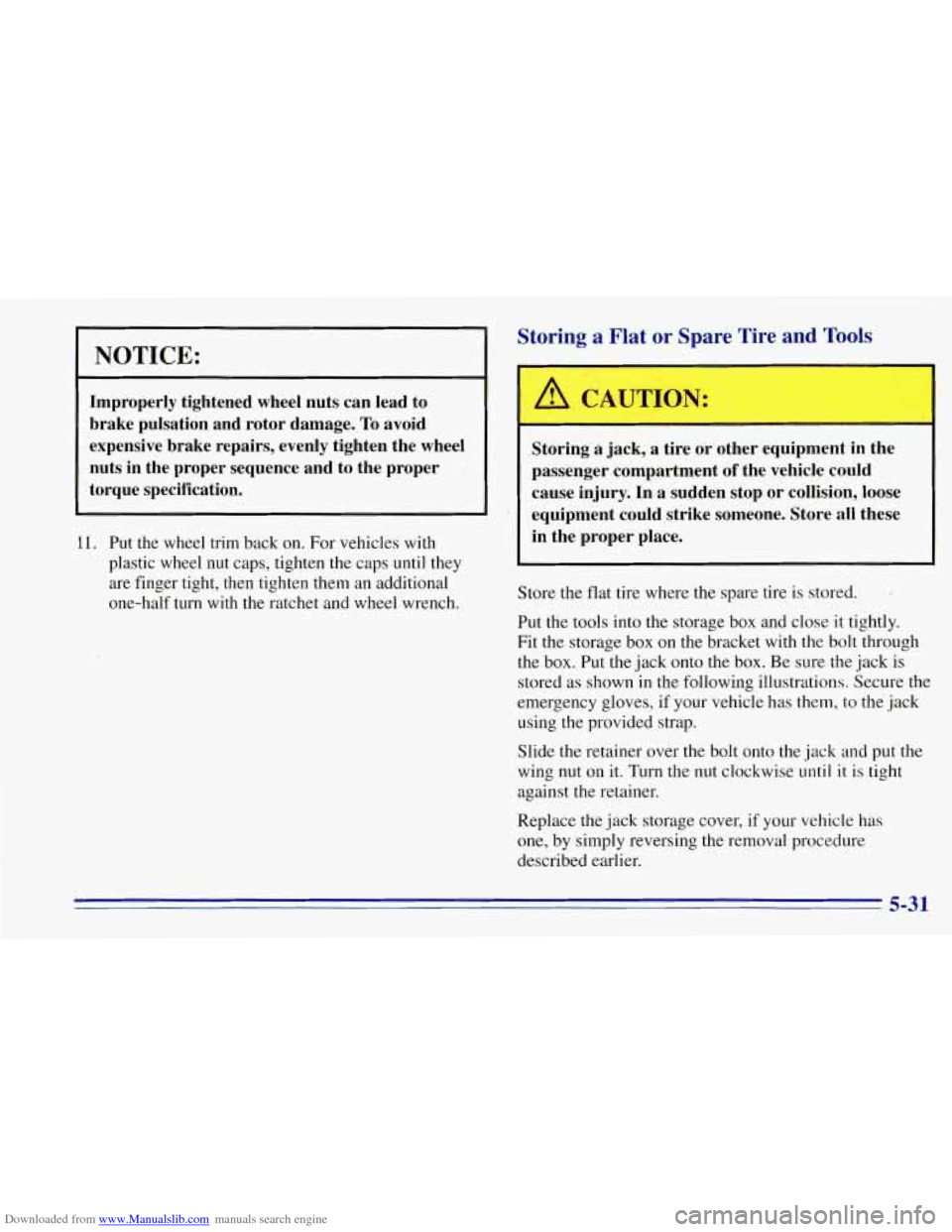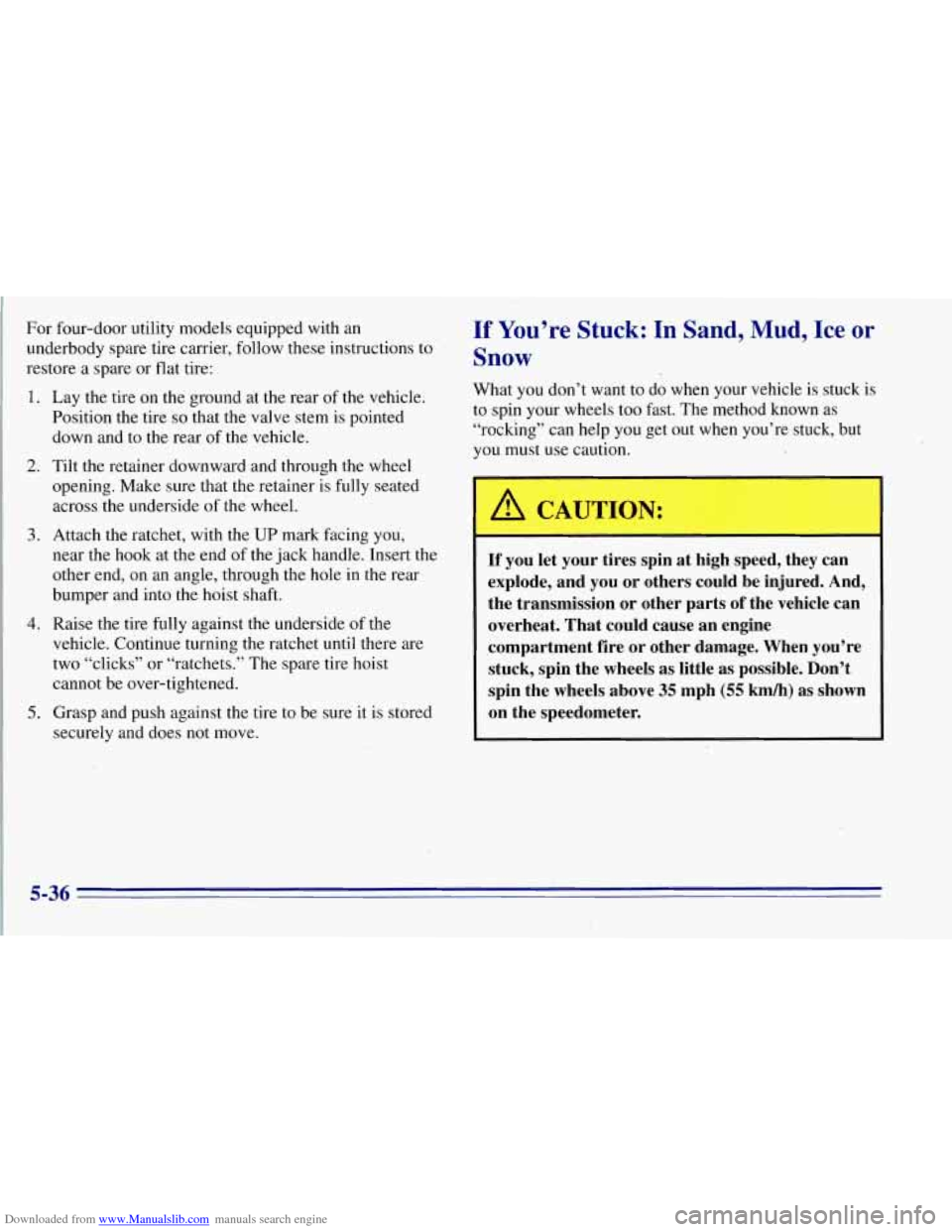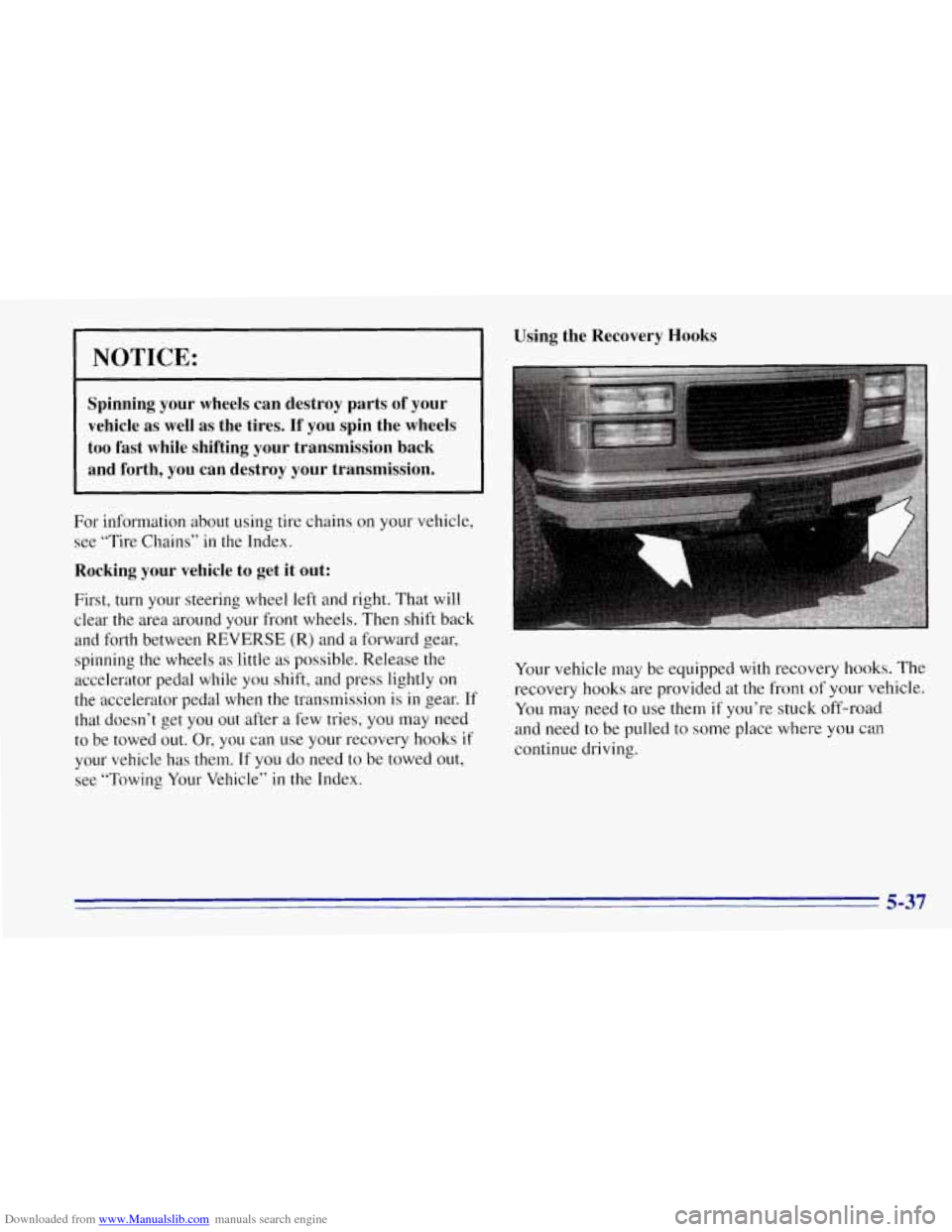Page 244 of 403
Downloaded from www.Manualslib.com manuals search engine A CAUTION:
- I
Never use oil or grease on studs or nuts. If you
do, the nuts might come loose. Your wheel could
fall
off, causing a serious accident.
7. Replace the wheel nuts
with the rounded end
of
the nuts toward the
wheel. Tighten each
wheel
nut by hand with
the wheel wrench until
the wheel is held against
the hub.
I
Front Position Rear
Position
8. Lower the vehicle by rotating the ratchet and wheel
wrench counterclockwise. Lower the jack completely.
5-29
Page 245 of 403
Downloaded from www.Manualslib.com manuals search engine 9. Tighten each wheel nut clockwise. 10. Tighten the nuts firmly in a criss-cross sequence as
shown. Rotate the wheel wrench clockwise.
A, CAUTION:
Incorrect wheel nuts or improperly tightened
wheel nuts can cause the wheel, to become loose
and even come
off. This could lead to an accident.
Be sure to use the correct wheel nuts.
If you have
to replace them, be sure to get new
GM original
equipment wheel nuts.
Stop somewhere
as soon as you can and haye the
nuts tightened with a torque wrench to the
proper torque. For proper torque, see “Wheel
Nut Torque” in the Index.
5-30
Page 246 of 403

Downloaded from www.Manualslib.com manuals search engine NOTICE:
Improperly tightened wheel nuts can lead to
brake pulsation and rotor damage.
To avoid
expensive brake repairs, evenly tighten the wheel
nuts in the proper sequence and to the proper
torque specification.
11. Put the wheel trim back on. For vehicles with
plastic wheel nut caps, tighten the caps until they
are finger tight, then tighten them an additional
one-half turn with the ratchet and wheel wrench.
Storing a Flat or Spare Tire and "001s
1 A CAUTION:
Storing a jack, a tire or other equipment in the
passenger compartment
of the vehicle could
cause injury. In
a sudden stop or collision, loose
equipment could strike someone. Store
all these
in the proper place.
Store the flat tire where the spare tire is stored.
Put the tools into the storage box and close
it tightly.
Fit the storage box
on the bracket with the bolt through
the box. Put the jack onto the box. Be sure the jack is
stored as shown in the following illustrations. Secure the
emergency gloves, if your vehicle has them, to the jack
using the provided strap.
Slide the retainer over the bolt onto the jack and put
the
wing nut on it. Turn the nut clockwise until it is tight
against the retainer.
Replace the jack storage cover, if your vehicle has
one, by simply reversing the removal procedure
described earlier.
5-31
Page 247 of 403
Downloaded from www.Manualslib.com manuals search engine Jacking Tool Storage
A. Wheel Wrench D. Jacking Tool Storage Box
B. Jack Handle E. Jack Handle Extension
C. Ratchet
D
E
Jack Storage -- 2-Door Utility Model
A. Retainer
B. Nut
C. Jack -- Secure in
Vehicle as Shown
D. Jack Storage Box
E. Bracket
Page 249 of 403
Downloaded from www.Manualslib.com manuals search engine Stow the flat tire in the cargo area of two-door Utility
and Suburban models and secure it to the tire carrier. To
stow the flat tire:
1. Put the cover back on the tire if your vehicle has one.
2. Put the flat tire in the cargo area of the vehicle, over
the retainer bolt.
3. Slide the adapter onto the bolt in the proper location
for your model and put the wing nut on.
4. Turn the wing nut clockwise until the adapter is tight
and secure against the wheel.
5. Close the tire cover, if you have one-
Spare Tire -- Two-Door Utility Model
1. Carrier 6. Cover
2. J-Bolt 7. Pins
3. Adapter 8. J-Bolt
4. Spare Tire 9. Use Upper Hole and Pin for P265
5. Nut Tire or Lower Hole and Pin for
LT225/245, P245 and
P235 Tires
Be sure the J-bolt is hooked properly for your model or
tire size
as shown.
5-34
Page 251 of 403

Downloaded from www.Manualslib.com manuals search engine For four-door utility models equipped with an
underbody spare tire carrier, follow these instructions to
restore a spare or flat tire:
1.
2.
3.
4.
5.
Lay the tire on the ground at the rear of the vehicle.
Position the tire
so that the valve stem is pointed
down and to the rear of the vehicle.
Tilt the retainer downward and through the wheel
opening. Make sure that the retainer is fully seated
across the underside of the wheel.
Attach the ratchet, with the UP mark facing you,
near the hook at the end
of the jack handle. Insert the
other end, on an angle, through the hole in the rear
bumper and into-the hoist shaft.
Raise the tire fully against the underside
of the
vehicle. Continue turning the ratchet until there are
two “clicks” or “ratchets.” The spare tire hoist
cannot be over-tightened.
Grasp and push against the tire to be sure it is stored
securely and does not move.
If You’re Stuck: In Sand, Mud, Ice or
Snow
What you don’t want to do when your vehicle is stuck is
to spin your wheels too fast. The method known as
“rocking” can help
you get out when you’re stuck, but
you must use caution.
n
I A CAUTION:
If you let your tires spin at high speed, they can
explode, and you or others could be injured. And,
the transmission or other parts
of the vehicle can
overheat. That could cause an engine
compartment fire or other damage. When you’re stuck, spin the wheels as little
as possible. Don’t
spin the wheels above
35 mph (55 km/h) as shown
on the speedometer.
5-36
Page 252 of 403

Downloaded from www.Manualslib.com manuals search engine NOTICE:
Spinning your wheels can destroy parts of your
vehicle as well as the tires. If
you spin the wheels
too fast while shifting your transmission back and forth, you can destroy your transmission.
For information about using tire chains on your vehicle,
see “Tire Chains” in the Index.
Rocking your vehicle to get it out:
First, turn your steering wheel left and right. That will
clear the area around your front wheels. Then shift back
and forth between REVERSE
(R) and a forward gear,
Using the Recovery Hooks
spinning the wheels as little as possible. Release the
accelerator pedal while you shift, and press lightly
on Your vehicle may be equipped with recovery hooks. The
the accelerator pedal when the transmission is in gear. If recovery hooks are provided at the front of your vehicle.
that doesn’t get you out after a few tries, you may need
You may need to use them if you’re stuck off-road
to be towed
out. Or, you can use your recovery hooks if and need to be pulled to some place where you can
your vehicle has them. If you do need to be towed out, continue driving.
see “Towing Your Vehicle” in the Index.
5-37
Page 275 of 403
Downloaded from www.Manualslib.com manuals search engine Rear Axle
When to Check and Change Lubricant
Refer to the Maintenance Schedule to determine how
often to check the lubricant and when to change it.
See “Scheduled Maintenance Services”
in the Index.
How to Check Lubricant
If the level is below the bottom of the filler plug hole,
you’ll need to add some lubricant. Add enough lubricant
to raise the level to the bottom
of the filler plug hole.
What to Use
Refer to the Maintenance Schedule to determine what
kind of lubricant to use. See “Recommended Fluids and
Lubricants” in the Index.
Four- Wheel Drive
Most lubricant checks in this section also apply to
four-wheel-drive vehicles. However, they have two
additional systems that need lubrication.
6-22